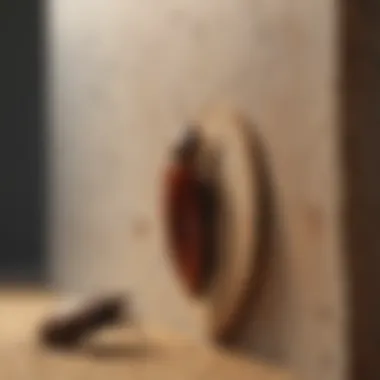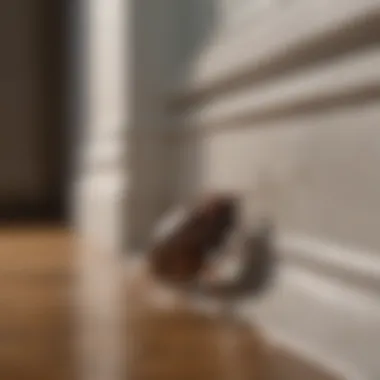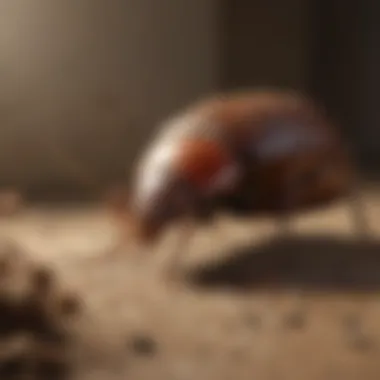Understanding How Roaches Enter Your Home: Pathways and Solutions


Intro
Cockroaches are more than just a nuisance; they are a resilient problem that plagues many households. These critters are known to thrive where it is warm and dark, often causing distress among homeowners who find them lurking. Understanding how these insects manage to invade our personal spaces is essential for effective prevention and management.
Getting to the root of the issue involves examining various pathways and entry points that allow cockroaches to settle comfortably in homes. From detecting the signs of an infestation to understanding their behavior and environmental triggers, this article will provide homeowners with a comprehensive approach to combat these unwelcome guests.
By adopting this knowledge, one can not only reduce the risk of a potential roach infestation but also take a proactive stance in maintaining a clean and healthy living environment.
Pest Identification
Identifying the pests that invade your space is crucial in any pest management strategy. Cockroaches come in many varieties, but some specific types are more common in homes:
Detailed Descriptions of Common Pests
- American Cockroach: Often found in basements and sewer systems, this large insect is reddish-brown. It can grow up to three inches long.
- German Cockroach: Smaller in size, this species is light brown with two dark stripes running down its back. They are notorious for being the most common household cockroach.
- Oriental Cockroach: Dark brown to black, this roach thrives in damp areas. It is often mistaken for a beetle due to its appearance.
Signs and Symptoms of Infestations
Knowing what signs to look for can save you from a bigger headache down the line. Here are key indicators:
- Droppings: Small, dark, and elongated droppings resembling coffee grounds or black pepper can be found in corners or beneath appliances.
- Egg Cases: These brownish capsules, known as oothecae, can often be found in hidden areas such as behind furniture.
- Unpleasant Odor: A musty smell often indicates an infestation, as cockroaches leave behind pheromones that create a foul odor.
"When you see one cockroach, it’s often the tip of the iceberg. Just because you don’t see more doesn’t mean they’re not there."
Prevention Strategies
Seeking entry points for cockroaches is vital in keeping your home pest-free. Prevention should be the name of the game.
Home Maintenance Tips for Pest Prevention
- Seal Cracks and Gaps: Check windows, doors, and foundations for any cracks that need sealing. These gaps can be highways for roaches.
- Regular Cleaning: Keeping your home clean, especially kitchens and dining areas, limits food sources for these pests.
- Proper Waste Management: Take out the trash regularly and store it in sealed containers to deter roaches from feasting.
Natural Deterrents and Barriers
Aside from chemical solutions, some natural alternatives can help:
- Diatomaceous Earth: This natural powder can kill roaches on contact by dehydrating them.
- Essential Oils: Certain scents, like peppermint or eucalyptus, tend to deter cockroaches. Try diffusing these oils in areas where roaches might enter.
Treatment Options
If prevention fails and roaches invade, it’s time to consider treatment options.
Overview of Chemical vs. Natural Treatments
Both approaches have their pros and cons. Chemical treatments are far quicker, but they can pose risks to pets and humans. Natural methods tend to be safer but might require more time to see results.
Step-by-Step Guides for DIY Treatments
- Boric Acid Mix: Blend boric acid with sugar and place it in areas where you've noticed roach activity. The sugar lures them in, and the acid does the rest.
- Soap and Water Spray: A simple mixture can kill roaches upon contact by suffocating them. Use a spray bottle for easy application.
By understanding these factors, homeowners can take steps to manage and minimize roach infestations effectively.
Prologue to Roach Infestation
When it comes to household pests, roaches hold a notorious place in the minds of many. Understanding roach infestations isn’t just about dealing with an occasional sighting; it’s essential for maintaining a sanitary home environment. A well-informed homeowner can handle potential infestations before they spiral out of control, saving not only time and money but also the stress that comes with such an unwelcome intrusion.
Roaches, being adaptive and resilient creatures, can easily turn a cozy home into a battleground. Each species of roach brings its own set of characteristics and challenges, making it essential for one to recognize the common types. Knowing what you’re dealing with helps tailor your approach to both prevention and eradication strategies.
The Common Types of Roaches
Before we dive into specifics, let’s familiarize ourselves with the main culprits that homeowners often encounter. Each type has distinctive traits that contribute to their habitat preferences and, consequently, the ways they find their way into our living spaces.
American Cockroach
The American cockroach is one of the largest house-invading species. It's not just the size that sets it apart but also its resilience. This cockroach can glide short distances and prefers warmer environments. A key characteristic of the American cockroach is its reddish-brown color and the yellowish band behind its head, which makes it relatively easy to identify.
Despite its intimidating appearance, it’s not the most common species found in homes—typically favoring public spaces like restaurants. However, if they infiltrate homes, their ability to breed quickly can lead to larger issues, making them a noteworthy focus in our discussion. It’s essential to keep an eye out for their presence in areas like basements or near sewer lines.


German Cockroach
In terms of common household ravagers, the German cockroach pulls no punches. It’s smaller—about half the size of the American cockroach—but it can reproduce at an alarming rate, with a female capable of producing up to 40 eggs at once. They thrive in human environments, often finding a cozy nook in kitchens or bathrooms, areas where food and moisture abound. Their key characteristic is a pair of parallel black stripes running down their backs, which helps in quick identification.
The German cockroach is a significant concern because it can carry harmful bacteria, which can contribute to health issues in humans. Understanding their preference for certain spaces emphasizes why keeping such areas clean is critical.
Oriental Cockroach
The Oriental cockroach, often referred to as a water bug, might be more common outdoors but certainly seeks shelter indoors when the weather turns unforgiving. A key feature of this roach is its shiny black or dark brown color and its reluctance to fly, which makes it seem more stationary compared to others. Its preference for very damp environments means that bathrooms and basements are its go-to spots.
This roach is often a sign of moisture problems, making it a two-fold issue; they not only invade homes but can also indicate leaks or excessive humidity, pointing toward necessary home repairs.
Brownbanded Cockroach
Finally, we have the brownbanded cockroach, often mistaken for its German counterpart due to its size and color, but it's easier to spot if you know what to look for. These cockroaches have distinctive light brown bands across their wings. Their unique feature is their preference for higher areas in a room, commonly nesting in furniture or electronics.
While they are less common than the German cockroach, their presence can still signal a need for action as they indicate that food sources are available nearby.
Understanding these common types of roaches not only informs homeowners of what pest they might be dealing with but also lays a foundation for effective prevention strategies. By being aware of these distinct characteristics and preferences, one can better prepare and fortify their home against potential invasions.
The Importance of Understanding Entry Points
Grasping where roaches come from is fundamental in tackling infestations. Knowing your enemy is only half the battle; recognizing how they invade is crucial. Entry points often tell a story of vulnerability in home structures, revealing how even the smallest gaps, cracks, or unnoticed spaces can become gateways for these pests.
From faulty sealants around windows to gaps in piping, each overlooked entry could pave the way for more significant issues down the road. Thus, keeping a vigilant eye on these potential weaknesses becomes invaluable for homeowners who wish to safeguard their living environments from these unwanted guests.
Identifying Common Entry Points
Identifying how cockroaches find their way into homes is crucial to any effective pest management strategy. By understanding the various entry points, homeowners can take proactive steps to block roaches from invading their living spaces. Not only can this knowledge help in preventing infestations, but it also aids in reducing anxiety associated with these troublesome pests.
Common entry points often serve as the sneaky highways through which cockroaches travel, going from the outdoors to the inside of the home. It’s essential to realize that even the tiniest crack can serve as a doorway for these resilient insects. More often than not, these entry points are overlooked, and without proper attention, they can lead to a significant infestation.
Cracks and Crevices
Cracks and crevices are prime pathways for roaches, as they can squeeze through spaces as small as a quarter of an inch. These gaps may occur in various areas of the home, especially around the foundation. Regular inspections of walls, floors, and even ceilings are crucial. Sealing these cracks not only fortifies your home but also keeps pests at bay.
A common oversight is neglecting the exterior. Many house owners are quick to check inside their homes but forget to inspect outside. A quick walk around the house can reveal cracked paint, damaged siding, or gaps around the foundation.
Gaps Around Pipes and Electrical Lines
Pipes and electrical installations are often necessary for our daily lives, yet they can also become unwitting conduits for cockroaches. Gaps where plumbing and wiring enter the house are typically ignored. These openings can lead directly to hidden areas conducive to roach nesting.
Sealing these gaps using caulk or foam can serve as a simple yet effective barrier. Taking action in these places also minimizes the risk of moisture buildup, which roaches find irresistable. Just remember, if these places are easy for you to ignore, they’re probably easy for roaches too.
Windows and Doors
Windows and doors are not only essential for ventilation but also key parts of your home’s defense against insect intruders. Poorly fitted windows or doors that don’t close tightly can serve as entry points. Weather stripping can make a huge difference here.
Moreover, screens can help keep unwanted pests out, but they need to be maintained. A tiny hole or tear can negate the entire purpose of a screen, so be sure to check regularly. Thoughtful maintenance of these areas ensures that they serve their intended purpose well.
Ventilation Systems
While ventilation systems may not be the first thing that comes to mind when considering roach entry, they can be significant culprits. Ducts and vents, if poorly maintained, can be an inviting pathway for roaches. Keeping these areas clean and sealed properly is essential for thwarting their access.
Additionally, installing high-quality filters can improve air quality while simultaneously curbing roaches from hitching a ride through your system.
The bottom line is that being informed about these entry points and addressing them can significantly reduce the chances of a cockroach infestation. Regular maintenance and vigilance are the keys to a roach-free home.
Environmental Factors Favoring Roach Entry
Understanding the environmental factors that favor roach entry is crucial for any homeowner. Environmental conditions significantly dictate not just the likelihood of a roach infestation, but also the severity and persistence of such an issue. Roaches are surprisingly resilient and adaptive creatures; they seek out environments that provide them with what they need to survive—moisture, food, and shelter. By recognizing these elements, you can better manage your home and ward off these unwelcome guests before they settle in.
Moisture Levels in and Around the Home
Moisture acts like a glowing neon sign for cockroaches. They thrive in humid areas, particularly because their bodies require a certain level of moisture to function. Leaky faucets, damp basements, or poorly ventilated bathrooms can become breeding grounds for these pests. Even the smallest puddle of water left behind can entice a roach to explore. It’s often said that roaches can live without food for weeks, but they'd hardly last a few days without water.
To reduce moisture levels, ensure that you regularly check for leaks and repair them promptly. Installing dehumidifiers, particularly in basements or crawl spaces, can also help maintain an environment less favorable to these pests.
"The best approach to roach management focuses on preventing their entry through effective moisture control."
Availability of Food and Water Sources
Cockroaches are opportunistic feeders. They don’t just scavenge for food; they target anything that’s left out in the open. Leftover crumbs, unsealed food containers, dog kibble, or even grease buildup in the kitchen can attract these creatures. Considering that they possess a remarkable ability to survive on very little, a single bowl of dog food could be enough to make your home inviting to them.
Cleaning your kitchen regularly is paramount. Here are some steps to minimize food sources:


- Seal food properly: Store dry goods in airtight containers.
- Clean leftovers: Wipe down surfaces after cooking.
- Dispose of trash regularly: Use bins with fitted lids to deter access.
- Limit pet food exposure: Feed pets only during mealtimes and remove any leftover food afterward.
Clutter and Hiding Places
Clutter is a roach’s best friend. It provides them with ample hiding spots and shields them from detection. Paper stacks, cluttered closets, and even unused appliances can create an ideal environment for roaches to flourish. Moreover, roaches are nocturnal, making it easy for them to exploit these hidden nooks without being noticed.
To combat this, keep spaces tidy and organized. Regularly declutter and remove unnecessary items from your home. Some quick tips include:
- Organize storage: Use clear, sealed bins for items you need to store.
- Regularly clean: Frequent vacuuming and dusting minimize potential roach hideouts.
- Utilize proper shelving: Elevating items off the ground can also reduce potential nesting spots.
Being mindful of these environmental factors can make a significant difference in your fight against roaches, helping to create a hostile environment for their invasion and, ultimately, protecting your home.
Behavioral Aspects of Roach Infestations
Understanding the behavior of cockroaches is crucial for effectively managing infestations. Knowledge of their movement patterns, habitat preferences, and foraging habits provides insight into how to prevent and control these pests. Recognizing these aspects can empower homeowners and pest control specialists alike, enabling them to devise targeted strategies to combat these resilient creatures.
Roach Movement Patterns
Roaches are not the fastest critters in town, but they are methodical. They tend to follow specific trails during their nightly escapades. These trails are often created by scent markings and pheromones left behind from previous journeys. Often, it's the same routes they take to find food or water sources.
They favor a low, flat posture, squeezing through tiny cracks and crevices along their way. Observing their movement patterns can reveal potential entry points and nesting sites. Additionally, a knowing glance at the areas where you often spot them can hint at how they navigate through your space, helping you identify weaker spots of your home's defenses.
Attraction to Human Habitats
Roaches have an uncanny knack for finding their way into our homes, often because they thrive in environments rich with resources. Human habitats provide an abundance of food scraps, warmth, and moisture, which are like a buffet for these pests.
They are particularly attracted to kitchens and dining areas, where crumbs and spills are common. Once settled, they are known to roam close to food sources while avoiding open spaces, making trash cans and discarded food the golden treasures of their existence. Ensuring proper food storage and cleanliness can make a significant difference in limiting their attraction to your home.
Nighttime Activity and Foraging
For many, knowing that roaches are nocturnal can be a chilling thought. These pests do most of their foraging when the lights go out. Their sensitivity to light makes them prefer darkness, which is why infestations often surface notably during the night.
Their main objective during these hours is simple: to search for food and water. During foraging, they often scatter but quickly regroup as they track familiar scents back to safety. This behavior underscores the importance of regular cleaning routines and keeping food sealed away to minimize attractants.
By recognizing and understanding cockroaches’ behavioral patterns, you take proactive steps toward prevention and containment, enhancing your chances of keeping your living space roach-free.
In summary, grasping the behavioral aspects of roaches sheds light on their entry strategies and survival tactics. This knowledge not only helps in prevention but aids in the formulation of effective treatment options when faced with a full-blown infestation.
Preventing Roach Entry Effectively
When it comes to defending your home against those stubborn little invaders known as cockroaches, taking the bull by the horns with prevention techniques is invaluable. Not only does preventing entry save you the headache of dealing with an infestation later on, it also creates a more pleasant and hygienic living space. After all, who wants to share their home with a bug that thrives in the messy corners? This section will explore three essential approaches that homeowners can take to keep these pests at bay: sealing cracks and gaps, utilizing screens and barriers, and putting proper waste management practices in place.
Sealing Cracks and Gaps
Roaches are crafty creatures, capable of squeezing through the tiniest cracks and crevices. Think of them as the original escape artists! The first step in roach-proofing your home involves patrolling every nook and cranny.
Here are some effective ways to seal up those sneaky entry points:
- Inspect thoroughly: Use a flashlight to examine areas around baseboards, windows, and doors for any gaps.
- Caulk away: A high-quality silicone caulk can fill in gaps. It’s not only durable, but it also adheres well to different surfaces.
- Expand foam: For larger openings, consider expanding foam. This method expands to fill larger voids that caulk might not cover.
Even if you think a gap is too small to matter, remember that a roach can easily slip through 1/8 inch, so sealing up every little gap offers a greater barrier.
Using Screens and Barriers
A proactive approach can make all the difference. Screens and barriers serve as the frontline defense in your anti-roach arsenal. Screens can be installed over vents and windows to keep pests where they belong—outside.
Here’s how to utilize screens and barriers effectively:
- Window screens: Make sure they fit snugly without any holes where roaches can sneak in. Check for tears and mend or replace them as needed.
- Vent covers: Install tightly fitted vent covers—these are particularly useful at preventing roaches from entering through cooling systems.
- Door sweeps: A door sweep can fill the gap under the door, blocking potential entry points. Choose a durable option that can withstand frequent use.
Utilizing these barriers not only aids in keeping roaches out, but also allows for ventilation within your home, ensuring that you aren’t compromising air flow in the process.
Implementing Proper Waste Management
A cluttered environment is like a bull in a china shop to cockroaches; it provides them with shelter and sustenance. Thus, proper waste management practices are vital in discouraging roaches from setting up shop in your home. Here are effective strategies:


- Seal your bins: Use bins with tight-fitting lids. Make it hard for those little pests to sniff out refuse.
- Regular disposal: Ensure trash is emptied regularly and doesn’t sit too long—especially food waste, which can attract roaches.
- Clean spills promptly: Any food crumbs or spills from meals should be cleaned up immediately. Roaches have an acute sense of smell and will zero in on even the slightest food residue.
"An ounce of prevention is worth a pound of cure." This couldn't be truer when it comes to roach infestations. Implementing these strategies may take some initial effort but will ultimately save time, money, and stress down the line.
In summary, preventing roach entry involves a three-pronged approach focusing on sealing cracks, reinforcing barriers, and adhering to smart waste management practices. By taking these steps, you lay the groundwork for a home that effectively repels unwanted guests.
Treatment Options for Existing Infestations
Dealing with cockroach infestations can be a considerable headache for any homeowner. Understanding the different treatment options is crucial in regaining control over your living space. Two primary methods are available: chemical solutions and natural remedies. Each has its benefits and considerations, which we’ll delve into further.
Chemical Solutions
Chemical solutions serve as a common line of defense against cockroaches. They tend to be effective in controlling and reducing pest populations significantly. Here are some aspects to consider when opting for this method:
- Speed and Efficacy: Many chemical treatments work quickly, usually showing noticeable results within days. In severe infestations, this rapid response can be essential.
- Variety of Products: There’s a wide range of products available, such as sprays, powders, and baits. Examples include Raid Ant and Roach Killer and Ortho Home Defense. Each has its specific usage, so reading labels is key.
- Accessibility: Chemical treatments can be found easily in local stores or online, making them a convenient option for many homeowners.
However, it's vital to approach these chemicals with caution. Here are a few considerations:
- Toxicity: Many chemical pesticides can be harmful to pets and children. Always read and follow the safety instructions on the packaging.
- Resistance: Over time, roaches can build immunity to certain chemicals. It’s advisable to rotate products to maintain effectiveness.
"Preventive measures paired with chemical solutions can exponentially increase the chances of long-term success in pest control."
Natural Remedies
For those seeking a more eco-friendly or less toxic approach, natural remedies can offer an effective alternative. These options provide homeowners with peace of mind, knowing they’re using safer products in their homes. Let’s take a closer look:
- Homemade Solutions: Common household items often serve as effective roach repellents. Solutions like a mixture of soap and water can suffocate cockroaches, while diatomaceous earth can dehydrate them upon contact.
- Essential Oils: Oils like peppermint or tea tree oil not only smell pleasant but also repel cockroaches. Mixing a few drops with water in a spray bottle can create a natural deterrent.
- Boric Acid: While it’s a naturally occurring substance, boric acid can be lethal to cockroaches. It needs to be applied correctly; otherwise, it might not be effective.
Considering natural remedies can lead to long-lasting solutions, but they generally require patience and persistence:
- Time: Unlike chemical solutions, natural remedies may take a little longer to show results. Homeowners should be prepared to apply these solutions regularly for best outcomes.
- Efficacy: While many swear by them, the effectiveness can vary. It may not always be enough for severe infestations.
To sum it up, both chemical solutions and natural remedies have their merits when it comes to treating cockroach infestations. Homeowners can choose the best path based on their specific situation, personal preferences, and response to the issue at hand.
When to Seek Professional Help
Determining when to call in the experts can often be as tricky as spotting a roach scuttling across the floor. Holding the reins when it comes to pest control might make you feel empowered, but sometimes that’s not enough. If you’re in a tight spot with these resilient critters, knowing when to seek professional help is crucial.
Cockroaches can rapidly go from a few unwelcome visitors to a full-blown infestation in a blink of an eye. Recognizing the specific elements that signal a need for a pro can certainly save homeowners from escalating their troubles.
Signs of Severe Infestation
If you’ve been keeping tabs on your living situation and getting the heebie-jeebies from seeing a roach or two, it might just be the tip of the iceberg. Here are some tell-tale signs that it might be time to consult a professional:
- Frequent Sightings: If you’re seeing more than one roach, especially during the day when they’re not supposed to be active, that’s a glaring red flag.
- Droppings: Tiny, dark grains that resemble pepper are a classic hint of a cockroach's presence, and a higher quantity equates to higher urgency. Check around kitchens, bathrooms, and other humid spots.
- Egg Cases: Finding discarded egg cases can solidify your understanding that you are dealing with a significant population.
- Foul Odors: A musty scent lingering, particularly in enclosed spaces, can hint at decaying organic matter and the presence of roaches.
- Damage to Material: Cockroaches have a penchant for munching on everything from paper to leather. If you notice unusual damage to such items, caution is warranted.
"Ignoring the signs is like closing the barn door after the horse has bolted."
Taking note of these signs can establish the groundwork for deciding the severity of your issue. Waiting too long may lead to larger infestations, which can be quite the headache to manage.
Evaluating Self-Treatment Effectiveness
Not every instance of pest trouble calls for a professional. However, gauging whether your self-treatment efforts are yielding results is just as important. Here are some factors to consider to make sense of your own methods:
- Timeframe: If you have been attempting self-treatment for a few weeks with no improvement, it might be time to rethink your strategy.
- Changes in Behavior: Are you still spotting roaches? If you see no reduction, despite following a solid control plan, it may indicate your methods aren't effective enough.
- Relying on Store-Bought Solutions: These DIY methods can fall flat if the infestation is deep-rooted. Products like sprays or traps might not reach all hiding spots.
- Recurring infestations: If you manage to eliminate them but they keep coming back, this flag goes up high. It implies there may be entry points or nests you are overlooking.
The assessment of your self-treatment is about being ruthlessly honest with yourself. If it’s not working like a charm, it’s time to seek help that isn’t DIY.
Epilogue
Recap of Effective Strategies
To reinforce the core message of this article, here’s a succinct recap of the effective strategies to prevent roaches from setting up camp in your home:
- Seal all cracks and gaps: Inspect baseboards, windows, and doors regularly. Utilize caulk to fill in spaces that allow easy entry.
- Maintain a clean environment: Regularly clean all areas of your home, ensuring that food crumbs and spills are promptly addressed. Roaches are drawn to any food source, no matter how small.
- Manage moisture levels: Address any leaks, turn off excess water sources, and keep your home well-ventilated to discourage roach habitation, as these pests thrive in moist environments.
- Store food properly: Keep food in sealed containers and use airtight bins for dry goods. This keeps snacks beyond reach.
- Professional help when needed: Don't hesitate to call pest control experts when you notice signs of a serious infestation. They can tailor an approach specific to your home's needs.
Emphasis on Ongoing Prevention
Prevention is ideally a continuous process rather than a one-time event. Once you take measures to safeguard against roach entry, it's vital to remain vigilant:
- Regularly inspect your home: Make it a habit to assess your premises for signs of wear and tear and address potential entry points before they become genuine issues.
- Educate your family: Ensure everyone in the household understands the importance of cleanliness and the role they play in prevention. Responsible habits can go a long way.
- Be aware of seasonal changes: Certain times of the year can see an influx of roaches as they seek warmth or moisture. Be extra cautious during these periods and increase your preventive measures.
- Utilize ongoing pest management: Consider integrating pest control services that offer prevention as a part of their package. Regular treatments can keep your home roach-free.
"An ounce of prevention is worth a pound of cure." This adage rings especially true for combating roach infestations. By focusing on preventive measures, you can save yourself a great deal of trouble and expense down the line.



